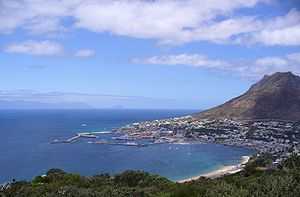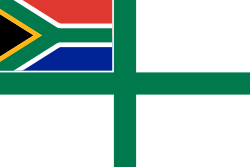Simonstown Agreement
| Military history of South Africa | |
|---|---|
| colspan="2" style="text-align: center;border-bottom:1px solid #2C6700;" colspan="2""|This article is part of a series | |
| Conflicts | |
| Khoikhoi–Dutch Wars Anglo-Dutch rivalry Xhosa Wars Ndwandwe–Zulu War Battles between Voortrekkers and Zulus Anglo-Zulu War First Anglo-Boer War Second Anglo-Boer War First World War Second World War Korean War Border War | |
| History of.. | |
| colspan="2" style="text-align: center;background:white;" colspan="2""|Army · Navy · Air Force · Medical Services · Special Forces
| |
| Lists | |
| Conflicts | |
The Simonstown Agreement (sic) was a naval cooperation agreement between the United Kingdom of Great Britain and Northern Ireland and the (then-officially) Union of South Africa signed 30 June 1955. Under the agreement, the Royal Navy gave up its naval base at Simon's Town, South Africa, and transferred command of the South African Navy to the government of South Africa. In return, South Africa promised the use of the Simonstown base to Royal Navy ships [1] The agreement also permitted South Africa to buy six anti submarine frigates, ten coastal minesweepers and four seaward defence boats[2] from the UK valued at £18 million over the next eight years. In effect, the agreement was a mutual defence arrangement aimed at protecting sea routes between the UK and the Middle East. The agreement was controversial because of South Africa's policy of racial separation known as apartheid.

There were three Simonstown Agreements, in the form of an exchange of letters between Minister Frans Erasmus and Selwyn Lloyd.[3]
These agreements were:
1) Agreement on Sea Routes around Southern Africa[3]
2) Transfer of the Simonstown Naval Base[3]
3) Ancillary Financial and Administrative arrangements[3]
The government of the UK terminated the agreement on 16 June 1975. Ships of the Royal Navy continued to call periodically at Simon's Town and other South African ports, however the Royal Navy was not able to use any South African ports during the Falklands War.
South Africa was a member of the Commonwealth at the time the agreement was signed, so the UK and South Africa took the position that the agreement was not an international treaty requiring registration with the United Nations under Article 102 of the United Nations Charter.
See also
References
- ↑ South African Institute of Race Relations. A survey of race relations in South Africa. Compiled by Hodgson, Tony and Muriel Horell. Johannesburg: South African Institute of Race Relations, 1976. p.43
- ↑ Lawrie, G C (1968). "Simonstown Agreement: South Africa, Britain and the Commonwealth". South African Law Journal 85: 162.
- ↑ 3.0 3.1 3.2 3.3 Lawrie, Gordon (October 1971). "Royal Institute of International Affairs". International Affairs 47 (4): 708–728. doi:10.2307/2625679.
| |||||||||||||||||||||||||||||||||||||||||||||
| ||||||||||||||||||||||||||||||||||||||||||||||||||||||||||||||
